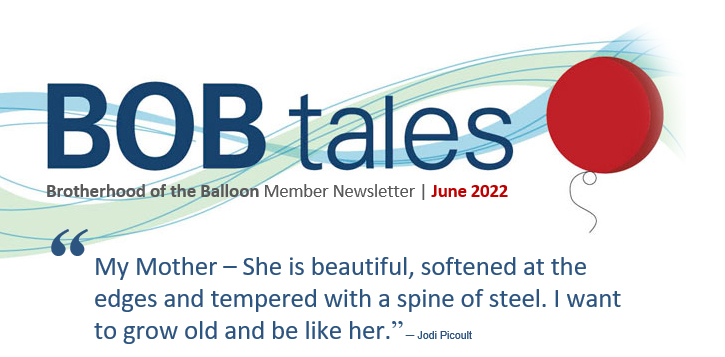
Dear Members (a note from Deb Hickey):
In past opening letters, I’ve written a lot about my father, Bob Marckini. I mean, why wouldn’t I? He’s the founder of this organization – or “ministry” – as we both like to call it; he’s the author of the two best books in the world on proton therapy – and other treatment options – for prostate cancer (I can say that, can’t I?); he’s counseled thousands of newly diagnosed men on prostate cancer treatment options (and hundreds of others on topics completely unrelated to prostate cancer, but he’s a guy who seems to know everything); and he’s the best father in the world (I happen to know this for certain).
We’re also approaching Father’s Day – when we’re all called to celebrate fatherhood and paternal bonds. So, it would be fitting for me to write again about my dad. But I’ll spare you all. Plus, I’m not sure I can top this opening memo from June 2020.
So, I want to write about another person – equally as important, brilliant, and slightly better looking than my father – my mother.
By the time you’re reading this, Mother’s Day will have passed. But I honestly feel that my mother Pauline deserves appreciation, recognition … gifts … every day of the year. First, I never knew how hard motherhood was until I became a mother. We all deserve awards – big ones.
Moms usually take care of the daily cleanups, activity planning, doctor’s appointments, play-date arrangements, school communication, homework help, laundry cleaning, teeth brushing, tear wiping, grocery shopping, meal planning, bed making, ironing, dish washing, lunch packing, nightly reading, pet feeding, toilet cleaning, life coaching, classroom volunteering, schedule organizing, personal styling, bill paying, entertaining, poop coaxing, rule enforcing, and crisis negotiating. Plus, some of them also have full-time jobs as my mom did for most of my childhood.
My mom did all those things … minus the rule enforcing and possibly the bill paying. But what I remember most about her – and what has stayed with me for the past 49-ish years is the selfless and unconditional love that she gave to me. It was more than the homework she helped with or the laundry she washed – it was the time she spent, the way she talked, and the gentle care she took.
I specifically remember her reading to me. I’d cuddle up next to her and pop my thumb in my mouth. She read Alexander and the Terrible, Horrible, No Good, Very Bad Day probably 600 times. Yet, she demonstrated the same level of enthusiasm the 600th time as she did the very first time.
When I was sick, she’d make sure my Big Bird bedsheets were clean and smelling fresh before I laid down. She’d get the TV tray and make the best scrambled eggs and toast I’d ever had. She’d ensure my stuffed Snoopy and baby Cathy were placed nearby in case I needed them during the night. If I had a fever, she’d dampen a facecloth and hold it to my forehead. I even remember the way her voice became softer and how she’d talk about herself in the third person: “Mummy will take care of you.”
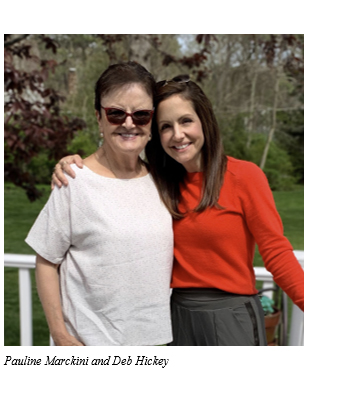 But don’t let the gentleness fool you. My mother was a pit bull if anyone crossed me. That kid who made fun of me at the bus stop knew the wrath of Pauline Marckini. … Or maybe that’s just the way I remember it. See, when I was bullied around the age of 10, I’d come running home, stubby little legs flying, tears streaming. And as I rounded the corner into my driveway, she was always waiting for me. It was as if she sensed I was coming. And then she’d make everything better.
But don’t let the gentleness fool you. My mother was a pit bull if anyone crossed me. That kid who made fun of me at the bus stop knew the wrath of Pauline Marckini. … Or maybe that’s just the way I remember it. See, when I was bullied around the age of 10, I’d come running home, stubby little legs flying, tears streaming. And as I rounded the corner into my driveway, she was always waiting for me. It was as if she sensed I was coming. And then she’d make everything better.
Some 40 years later, my mother is still my safe place. She knows me better than anyone. She knows what I’m feeling when I don’t say anything at all. And she accepts me in everything that I do and everything that I am. And yet she never stops mothering. If she thinks I’m hurting, she’ll ask thoughtful questions, offer an ear, and then later write me a letter with her thoughts, observations, and advice. Then she’s always afraid any constructive criticism hurt my feelings. I don’t think she could hurt me if she tried.
As author Jodi Picoult said, “My Mother – She is beautiful, softened at the edges and tempered with a spine of steel. I want to grow old and be like her.”
I do. I really do.
Happy Mother’s Day, Mom.
And, since June 19th is Father’s Day, I want to wish all the dads in our group a bright and blessed day!
-------------------
June is National Cancer Survivor Month. It’s a time to celebrate life and encourage those still battling cancer, as well as their families. It’s a time to give hope to those who’ve been recently diagnosed and gather support for their caregivers. It’s also a time to increase awareness about cancer, early screenings, and treatment options, and a time to advocate for more resources and access to all treatment options.
This month, we share some exciting research that may represent a breakthrough in the quest to generate high-speed proton particles at considerably lower cost. We report on a new study – the first of its kind to pool data from multiple, global prostate cancer clinical trials – that shows improved survival outcomes in prostate cancer patients who add ADT to their treatment protocol. We warn readers about private Medicare plans that claim to offer greater benefits, but work to improve their profitability while refusing to pay for more costly procedures like proton therapy for prostate cancer. We report on a hugely successful proton therapy lawsuit one family filed against a United Healthcare company. We spotlight a BOB member and taekwondo master who’s celebrating his 15-year post-proton anniversary. And you’ll find our fourth How Not to Die series on high blood pressure, the number one risk factor for death.
As always, we love to get feedback on the newsletter, and welcome any suggestions you have on how to improve the value of the BOB Tales to our members. Just send an email to [email protected].
Deb Hickey
To print the BOB Tales newsletter or view the newsletter with a larger font size, click here for the PDF file. .jpg)
.jpg)
In This Issue:
- Laser-Based Proton Therapy – A Potential Game Changer
- The Benefits of Adding and Prolonging Hormonal Therapy
- Beware: Private Medicare Plans Often Deny Care
- Family Wins $200m in Proton Therapy Lawsuit
- How Not to Die from High Blood Pressure
Laser-Based Proton Therapy—A Potential Game Changer
It’s well known that proton therapy offers distinct advantages over conventional X-ray radiation, including the most advanced forms of IMRT and SBRT. One of the biggest obstacles to proton therapy has been the insanely high cost of the equipment required to accelerate the proton particles to an energy/speed where they can effectively penetrate human tissue to deliver their cancer-killing power. Expensive particle accelerators such as cyclotrons and synchrotrons typically cost tens of millions of dollars. The high capital investment limits the number of proton centers that can be built, and also translates into much higher cost for treatment. This leads to subsequent battles with private medical insurers who often refuse to pay for the higher-cost option.
Proton Capacity for Fewer Than 1 Percent of Patients
Even though there are more than 40 proton treatment centers in the U.S. and close to 100 worldwide, this represents treatment capacity for fewer than 1 percent of patients worldwide who could benefit from the healing power and lower toxicity of proton beam therapy.
Numerous efforts have been under way to lower the cost of proton therapy including clinical research using hypofractionation where higher doses of proton radiation are delivered in fewer fractions (treatments); developing lower cost, single-room, free-standing treatment systems; and other endeavors.
A Breakthrough
Some exciting research has been under way in Dresden, Germany that could represent a breakthrough in the quest to generate high-speed proton particles at considerably lower cost. This important research was reported recently in the journal Nature Physics, and in Science Daily on March 14, 2022.
The technology involves directing a high-power laser at a thin plastic or metal foil in extremely short pulses. The laser flash displaces large clusters of electrons from the foil, creating a strong electric field that generates pulses of high-energy protons. The acceleration path is exceptionally short, only a few micrometers long; that’s one-millionth of a meter!
Researchers at the OncoRay National Center for Radiation Research in Oncology at Dresden University Hospital have been working to develop this technology for 15 years. The greatest challenge has been learning how to control the resulting proton beam as well as generating enough energy to be sufficient for irradiating a tumor deep inside the body.
Over the past few years, scientists have made excellent progress with a better understanding of the interaction between the laser and the foil. The significant intensity of the beam generated by this technology will allow doctors to administer the entire dose within a millionth of a second, further enhancing the proton particle’s ability to destroy the tumor while sparing healthy surrounding tissue.
“There are indications that such a rapid dose administration helps spare the healthy surrounding tissue even better than before,” says researcher, Dr. Elke Beyreuther. “We want to follow up on these indications with our experimental setup and conduct preclinical studies to investigate when and how this rapid irradiation method should be used to gain an advantage in cancer therapy.”
Current pre-clinical research is based on animal testing and is showing much promise. This exciting, new laser-based proton therapy could be a game changer. Stay tuned.


The Benefits of Adding and Prolonging Hormone Therapy
Adding androgen deprivation therapy (ADT) to radiation therapy improves survival results in patients with localized prostate cancer, according to a recent study published in The Lancet Oncology. Furthermore, prolonging hormonal therapy in patients with intermediate-risk and high-risk prostate cancer provides significant benefits.
Researchers pooled data from multiple, global prostate cancer clinical trials to create this first-of-its-kind meta-analysis. In addition to observing the benefits of adding and prolonging ADT, researchers also studied the benefits of extending the duration of ADT preceding radiotherapy.
Metastasis-free survival was improved with the addition of ADT to radiotherapy and the prolongation of ADT. However, researchers saw no benefit in extending the duration of neoadjuvant ADT, which is sometimes given as a first step to shrink a tumor before treatment.
“Regardless of radiotherapy dose, patient age or prostate cancer risk group — as defined by the National Comprehensive Cancer Network classification — the addition of ADT to radiotherapy and prolonging adjuvant ADT improved all clinical endpoints, including overall survival,” said lead researcher, Amar U. Kishan, MD. “The number of men we would need to add ADT to, or prolong adjuvant ADT for, to avoid one man developing a metastasis is very low depending on the specific risk group and intervention. On the other hand, extending neoadjuvant ADT offered no benefit for any patient.”
According to Dr. Kishan, these findings provide the strongest level of evidence so far to the magnitude of the benefit of ADT treatment intensification with radiotherapy for men with localized prostate cancer.


Beware: Private Medicare Plans Often Deny Care
This is the headline from an article in USA Today on May 2, 2022, which reported on a study conducted by the U.S. Department of Health and Human Services. It helps clarify something we’ve been seeing over the past few years.
Typically, Medicare covers proton therapy for prostate cancer and many other disease sites. But we’ve heard from newly diagnosed patients around the country that private Medicare insurers are often denying coverage. This latest report tells us that many private Medicare plans have routinely denied 18 percent of claims allowed under regular Medicare coverage rules. The report further states that “private Medicare plans turned down 13 percent of authorizations for medical services that government-run Medicare would have allowed.”
These private Medicare plans are becoming increasingly popular. They cover 28 million older and disabled Americans. It’s estimated that by 2030, more than half of Medicare beneficiaries will be enrolled in private Medicare plans.
When these plans are marketed, they offer perks that include limited out-of-pocket cost, vision and dental benefits not covered by traditional Medicare, gym memberships and more. But these are for-profit companies and they’re continuously trying to find ways to reduce costs and improve profits. According to the article, “the plans employ private insurance industry tactics to reduce costs. These plans restrict networks of doctors and other medical providers, mandate authorization for some services and require referrals for specialists.” They apparently strive to improve their profitability by refusing to pay for more costly procedures that traditional Medicare covers, such as proton therapy for prostate cancer.
The leader of the investigation, a Medicare Advantage expert, said, “beneficiaries may be denied care they need or might pay for services their plans should cover,” which leads to denials, appeals and much administrative work, particularly on the part of patients.
So, beware of falling into the trap of signing up for a private Medicare plan that – on the surface – appears to provide more services and at a lower cost. As the saying goes, “If it sounds too good to be true, it probably is.”


Family Wins $200m in Proton Therapy Lawsuit
 In 2015, Bill Eskew and his son were on a golf course in Las Vegas when Mr. Eskew felt a sharp pain in his arm. He thought he’d dislocated his elbow.
In 2015, Bill Eskew and his son were on a golf course in Las Vegas when Mr. Eskew felt a sharp pain in his arm. He thought he’d dislocated his elbow.
Doctors later discovered the pain was a pathological fracture from lung cancer, though Mr. Eskew had never been diagnosed with the disease prior to that point.
Shortly thereafter, Mr. Eskew met with a renowned radiation oncologist at MD Anderson Cancer Center who recommended he receive proton beam therapy because she believed it would reduce the risk of serious side effects.
To the Eskew’s dismay, their health insurer, Sierra Health and Life, a United Healthcare company, denied coverage. Without any investigation, the company automatically rejected the claim as part of a hidden medical policy, saying the treatment is “considered unproven and not medically necessary for treating lung cancer.”
Mr. Eskew had no other option than to undergo IMRT. According to Mr. Eskew’s attorneys, the treatment caused severe damage to Mr. Eskew’s esophagus resulting in tremendous suffering. Mr. Eskew couldn’t eat or drink without significant pain or food getting stuck in his throat. “He became a shell of himself,” said attorney Matthew L. Sharp.
Mr. Eskew passed away in March 2017.
Mr. Eskew’s widow, Sandy Eskew, brought a lawsuit against Sierra Health and Life. After a 13-day trial, the jury found the company had breached its duty of good faith and fair dealing. The family was awarded $40 million in compensatory damages and $160 million in punitive damages.
“This was a case about an insurance company who operated as though it was above the law. Sierra denied Bill’s claim without fairly considering the insurance policy it sold him and without a good faith investigation,” said Sharp.

‘My Life Started Over Again When I was Diagnosed with Prostate Cancer…’
“I believe in angels. I haven’t actually seen the ones with wings, but I am absolutely certain they exist…” – Dave Pratt
----------------------
BOB member Dave Pratt is a pretty faithful guy. If you read his blog, you’ll understand why. The entry that resonated with us most is titled “Everyday Angels.” Dave shares a few encounters with “angels” that changed his life – including a call from Al, a “total stranger,” who was referred to him by a mutual friend.
According to Dave, Al called “out of the blue” just weeks before Dave was due to have a prostatectomy to treat his prostate cancer. Just 52 at the time, he was very concerned about side effects, though his urologist was adamant that surgery was his best option.
But when Al said, “Don’t do it. You have other options…” Dave listened. Al told him about proton therapy and his own experience of treatment and life after treatment.
The next day, Dave called Loma Linda University Cancer Center and scheduled a consultation. He subsequently fired his urologist and canceled his surgery.
----------------------
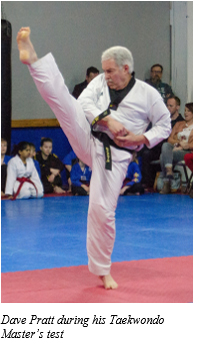 This May marks 15 years since Dave was treated with proton therapy for his prostate cancer. He’s never had any side effects and his PSA is “practically unmeasurable.”
This May marks 15 years since Dave was treated with proton therapy for his prostate cancer. He’s never had any side effects and his PSA is “practically unmeasurable.”
Shortly after his treatment ended, Dave mastered Taekwando and spent many years teaching the sport as a volunteer at his local Boys and Girls Club. Eight years after treatment, Dave made the U.S. National Team and competed at the Pan American Championships. “That was fun!” Dave said of the experience.
“I’ve finally started to power down a bit,” Dave said recently. Now in his late 60s, he still practices tai chi and is a 4th degree master at taekwondo. He also teaches project and program management in the corporate and continuing education program at his local college, volunteers for Hire Heroes USA, an organization that helps veterans transition to the private sector, and loves spending time with family.
Somehow all of this isn’t enough to keep Dave busy because he also writes. In addition to his blog, he’s written several books on project management, a book called Voices from the Prostate Underground that includes first-hand stories from prostate cancer survivors, and a Christian suspense novel, The Home Team, which is due to be published soon. He’s also under contract to write a second Christian suspense novel by the end of this summer.
Dave has referred many men to the Brotherhood of the Balloon and proton therapy over the years, “I enjoy speaking to others about my proton therapy experience and outcome.” Dave has also made a contribution to proton research at Loma Linda as a “thank you” for his experience.
Dave plans to head back to Loma Linda for a visit within the next couple of months. “I’d like to attend a Wednesday night support group meeting – do they still have those?” Dave asked. Deb Hickey was pleased to inform Dave that they do, indeed, still hold Wednesday night meetings. In fact, they offer a catered meal, a masseuse, graduation ceremonies, and an educational speaker on various topics about healing. The patient services group at Loma Linda also plans to start up an exercise program on Fridays at their on-campus fitness facility, the Drayson Center. The patient programs also include golf outings. “Wow! I’m in,” said Dave.
“In many ways, my life started over again when I was diagnosed with prostate cancer and entered Loma Linda’s proton therapy program,” said Dave. “The Christian atmosphere, though not emphasized during treatment at all, was something you could feel in the air. It was positive, supportive, loving, and effective. Since my treatment, I’ve enjoyed a great quality of life.”
“I don’t think anyone can fully appreciate how personal and impactful a cancer diagnosis can be to a person’s life except someone who has gone through it or is going through it,” Dave continued. “Given that, the cancer patient needs to be the one to make the decisions about his treatment and care. The decision can’t be delegated to the urologist, family practitioner, friend, or family member. The patient should work to understand and identify all his options before selecting a mode of treatment. Bob Markini’s book is a must-read from that perspective. Anyone who does the research will quickly learn that for so many prostate cancer patients, proton radiation is the best approach. I’ve certainly benefited from that decision. I cannot recommend Loma Linda and proton therapy enough. I thank God that He pushed me in that direction.”

We’ve been producing BOB Tales newsletters for more than 20 years. During this time there have been articles that many new members haven’t seen, and some older members may have forgotten. So, we periodically re-run articles from past newsletters. The following is from January 2007.
You Want to Remove My What?!
(Or … One More Reason to Seek a Second Opinion)
We heard from a gentleman last month whose PSA was in the teens with a Gleason 3+3, T1c stage cancer. He told us his doctor recommended he have a bilateral orchiectomy. That’s castration!
He decided to seek a second opinion, and learned he had several other options, including proton therapy, which he has decided to do at Loma Linda University Cancer Center.
There’s a message here: Just as in other professions – not all doctors are created equal. A second opinion will never hurt, and it often helps you make the decision that’s in your best interest.
On that same subject, the NBC Today Show recently reported on a study conducted at the University of Michigan where patients with cancer and other serious illnesses sought second opinions once given a recommendation from their primary physician. In 52 percent of the cases (i.e. more than half) the patients learned that another option was in their best interest. We think most BOB members can relate to that story.

Contributor Quotes
Every month, we receive a list of members who’ve made contributions to the Robert Marckini Chair for Proton Therapy Research at Loma Linda University Cancer Center, though we don’t know the exact amounts given. We make every attempt to get in touch with everyone on these lists by phone to thank them for their generosity. We love the conversations we have, and we often save some of their comments. Following are a few recent examples.
The power of proton therapy is undeniable! I’m happy to be here! ─BOB Member, Spokane, WA
Cancer research saves lives. And proton therapy is the most advanced, precise treatment for cancer. I’d like others to have the opportunity to have proton therapy like I did. ─BOB Member, Apopka, FL
Why do I give? Because I have not spent one dollar on medicines or follow-up procedures in my 20 years post-proton treatment. ─BOB Member, Uniontown, PA
My monthly gift is just a small token of my appreciation of the joyful treatment experience I had and the new lease on life I’ve been given. ─BOB Member, Alameda, CA
My wife and I were very impressed with Seventh-day Adventists and to this day are surprised and appreciative of the amazing way we were treated during our stay. ─BOB Member and Spouse, Long Lake, MN
I’m thankful I still have my prostate! And I’m thankful to Dr. Rossi at California Protons for my great treatment. And we owe it all to Loma Linda. ─BOB Member Kingsburg, CA
Don't Just Stand There
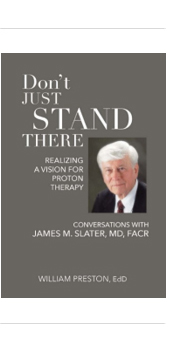 In an effort to boost funding for basic and clinical proton therapy research we asked our members to donate $100 (or more) to Loma Linda University Cancer Center. In return, they’d receive a copy of Dr. William Preston’s book, Don’t Just Stand There – Realizing a Vision for Proton Therapy: Conversations with James M. Slater, MD, FACR. Thank you to all who’ve requested a copy!
In an effort to boost funding for basic and clinical proton therapy research we asked our members to donate $100 (or more) to Loma Linda University Cancer Center. In return, they’d receive a copy of Dr. William Preston’s book, Don’t Just Stand There – Realizing a Vision for Proton Therapy: Conversations with James M. Slater, MD, FACR. Thank you to all who’ve requested a copy!
If you’d like a pre-published copy of “Don’t Just Stand There,” please send a check for $100 or more, payable to “Loma Linda University Proton Cancer Research” and mail it to:
Loma Linda University Health ● Office of Philanthropy ● PO Box 2000 ● Loma Linda, CA 92354
Please notify Deb Hickey at [email protected] that you’ve sent in your check and your book will be mailed immediately.
Giving Options
- Donate to proton research online.
- Write a check to LLUCC Proton (Put “Marckini Chair” on the memo line) and mail to LLUH, Office of Philanthropy P.O. Box 2000, Loma Linda, CA 92354.
- Make an unrestricted gift (put “unrestricted” on memo line) so LLUH can use it where it’s needed most.
- Call Regina Joseph at 909-558-5010 to donate over the phone.
.jpg)
.jpg)
How Not to Die from High Blood Pressure
By Bob Marckini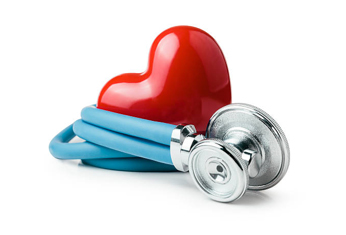
In our March BOB Tales we told you about an important new book, How Not to Die, that was brought to our attention by our good friend, BOB member Charles Smithgall. “The book changed my life,” Charles said.
The author, Michael Greger, MD, is the founder of Nutritionfacts.org, a science-based nonprofit that follows and reports on the latest in nutrition research. In his book, Dr. Greger addresses the 15 leading causes of premature death that take the lives of 1.6 million Americans annually. And he says, “this doesn’t have to happen.”
By reading Dr. Greger’s book, which is backed up by a mountain of documented scientific evidence, you can learn about diet and lifestyle choices that can literally help you slow, stop, and even reverse many diseases to live a longer and happier life.
In our March issue we reported on “How Not to Die from Prostate Cancer.” In April we covered the No. 1 killer in the U.S., “How Not to Die from Heart Disease.” Last month we addressed another serious disease, “How Not to Die from Diabetes.” This month we’re dealing with another serious health issue that’s shortening millions of lives each year, high blood pressure, or hypertension.
We’ve received lots of feedback from members on our first three articles, thanking us for the series and letting us know that they are making changes in their lives, losing weight and eating healthier. It’s nice to know that members are reading our articles and making healthy choices. Here’s what one member wrote in an email last month:
Reading your article in the latest BOB Tales inspired me to lose weight. So I’m cutting out meat, excess sugar, and eating late. I lost five pounds in a week! Five more to go by my May 2 wellness appointment – then seven pounds after that to get to 24 BMI.
I should know better, too, having been raised a vegetarian. My SDA parents quit eating meat when I was about three.
Thanks for all you do for the proton cause!
The No. 1 Risk Factor for Death
The Bill & Melinda Gates Foundation funded a study on causes of death, that was published in Lancet, one of the world’s leading medical journals. The study was one of the largest and most comprehensive medical studies ever conducted. It involved 500 researchers from 50 countries.
One major conclusion from the study is that the No. 1 factor for death is high blood pressure, also known as hypertension, which kills nine million people worldwide each year. High blood pressure is linked to deaths from stroke, aneurysms, heart failure, kidney failure and other diseases.
Normal Blood Pressure
Blood pressure is a measure of systolic (artery pressure from the heart pumping) and diastolic (artery pressure when your heart is resting between beats). The units of blood pressure are millimeters of mercury (mmHg) and the measurement is reported as systolic/diastolic.
The American Heart Association considers normal blood pressure to be essentially anything lower than 120/80. A pressure above 140/90 is considered hypertensive, with numbers between these two levels referred to as prehypertensive.
Close to 80 million people in the U.S. suffer from high blood pressure. High blood pressure puts considerable strain on the heart and can cause damage to the eyes, kidneys, brain and other organs in the body.
Not surprising – considering the theme of the other articles in this series – those people and societies that consume a whole-food plant-based diet consistently experience blood pressures in the normal range. Numerous examples are presented by the author that support this finding. Studies, in fact, have proven conclusively that diet is the No. 1 culprit. Quoting Dr. Greger:
“High blood pressure appears to be a choice. You can continue eating the artery-busting Western diet, or you can choose to take off the pressure. The truth is that eliminating humanity’s primary risk factor for death may be simple. No drugs, no scalpels. Just forks.”
Salt
Dr. Greger feels that the two most important dietary factors are eating too much salt and not eating enough fruit. A healthful diet, consisting of lots of fruits and vegetables provides all the salt you need. Additional salt, from processed foods and saltshakers, contributes to water retention, which leads to hypertension.
The American Heart Association recommends less than 1,500 mg of sodium daily, which is about three-quarters of a teaspoon of salt. Most Americans consume twice that amount. Reducing excess salt could reduce blood pressure and dramatically reduce deaths from strokes and heart attacks.
“Malignant hypertension” is extremely high blood pressure that can cause organ damage. A study as far back as the 1940s showed that patients with malignant hypertension (240/150), which causes eye bleeding, kidney shut down and heart failure, was brought down to normal levels (105/80) though salt reduction and a plant-based diet.
The Food Industry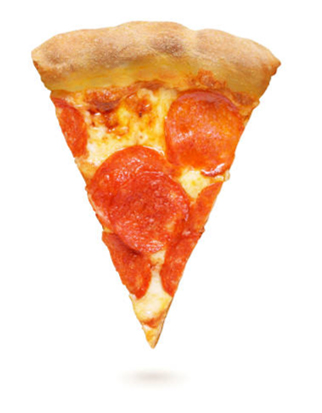
The trillion-dollar processed food industry is clearly a villain in all this. They typically add very inexpensive salt to meat, for example. This causes the meat to absorb water which increases its weight. We all know that meat is sold by the pound. And, since salt can add as much as 20 percent more weight, it can also bring in 20 percent more profit.
Dr. Greger poses a quiz in this chapter, which I failed. He asked, “Which has been reported to contain the most sodium: a serving of beef, a serving of baked all-natural chicken, a large McDonald’s French fries, or a serving of salted pretzels?” Answer: The chicken!
Products labeled “100 percent natural chicken,” for example, are often injected with salt water to artificially increase their weight. According to Consumer Reports, some supermarkets are selling chicken so pumped up with salt, they contain 840 mg of sodium per serving. That’s more than a day’s worth of sodium in one chicken breast. Buyer beware!
And, while chicken is one of the worst salt offenders, there are other foods that contribute to the salt overload. One slice of pizza, for example, may contain half your recommended daily sodium limit.
Kicking the Salt Habit
Reducing salt intake is relatively easy. By cutting back on high-salt foods, and retiring your saltshaker, studies have shown your taste buds readjust to your new diet, and foods begin to taste good again. Dr. Greger says that the same is true for sugar and fats. But cutting back on these dangerous foods, your taste buds acclimate to your new diet, taste receptors in your mouth readjust, and food that initially tastes bland, begins to taste good again. It takes some discipline and a little time, but it works.
Whole Grains
Whole grains have been shown to provide a significant benefit in lowering blood pressure, similar to the benefit from taking blood pressure-reducing drugs, but without the side effects. The best whole grains to add to your diet are foods like oats, whole wheat and brown rice.
The DASH Diet
The Dietary Approaches to Stop Hypertension (Dash) diet recommends fruits, vegetables, low-fat dairy and some meat. The intent of this diet is to move individuals in the direction of a plant-based diet, but to include some animal products to make them palatable to non-vegetarians. The DASH diet has been shown to help bring down blood pressure, but experts agree, the vegetarian diet is better at achieving lower hypertension goals.
Other Foods and Activities
Ground flaxseeds, hibiscus tea and nitrate-rich vegetables can also help to reduce blood pressure.
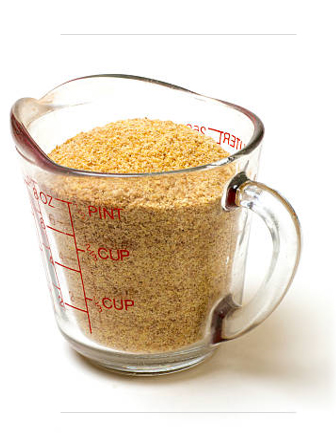 A study reported in The Journal of Hypertension (yes there is such a publication) reports that ground flaxseed “induced one of the most potent blood-pressure-lowering effects ever achieved by a dietary intervention.”
A study reported in The Journal of Hypertension (yes there is such a publication) reports that ground flaxseed “induced one of the most potent blood-pressure-lowering effects ever achieved by a dietary intervention.”
Both raw and cooked vegetables can also help, but raw vegetables seem to be more protective. Also beneficial, but less so, are beans, split peas, chickpeas, lentils, and watermelon.
Dr. Greger also reports on the benefits of nitrous oxide (NO), which helps relax the muscle fibers in your arteries. NO can come from antioxidant-rich plant foods that are rich in nitrates. Beets and beet juice, for example, are rich in nitrates. Greger also lists the top-10 food sources for nitrates, with Arugula taking the prize for the top spot.
And don’t forget exercise, particularly endurance exercise. When combined with good diet choices endurance exercise can help to reduce blood pressure.
Summary
High blood pressure has become an epidemic in most developed countries, particularly in the U.S. It has become the No. 1 risk factor for death according to a major comprehensive study. The western diet with excessive salt and the food industry are significant contributing factors. Reducing salt intake, increasing whole grains, fruits, vegetables and increasing endurance exercise all help to reduce blood pressure and greatly improve quality of life.
The author concludes the chapter on How Not to Die from High Blood Pressure with case histories of three people. All were obese and all suffered from hypertension and other serious health problems. After switching to a whole foods plant-based diet, all three lost significant weight, their health measurements (BP, cholesterol, triglycerides, etc.) returned to normal, and they were able to stop taking their blood pressure medications.
Once again, quoting Dr. Greger, “High blood pressure appears to be a choice. You can continue eating the artery-busting Western diet, or you can choose to take off the pressure. The truth is that eliminating humanity’s primary risk factor for death may be simple. No drugs, no scalpels. Just forks.”

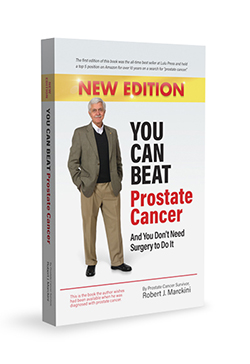 You Can Beat Prostate Cancer: And You Don’t Need Surgery to Do It –Second Edition
You Can Beat Prostate Cancer: And You Don’t Need Surgery to Do It –Second Edition
The Audiobook
The audio version of Bob’s book is available on Amazon, iTunes, Walmart, Nook, Blinkist, Scribd, Kobo, Hoopla, Google Audiobooks, and 37 other platforms. We don’t have any specific information yet on sales volume, but we know from recent feedback that some newly diagnosed men have already found the audiobook; they’re listening to it; and, we expect they’ll find it helpful. With more and more people “reading” their books in audio format, this is just one more way of telling the world about the benefits of proton therapy for treating prostate cancer.
If you’d like to hear a new five-minute segment of the book, click here. This is the audio sample, which is available on the Amazon website as well as the websites for all 43 audiobook distributors.


Step 8 in the 10 Steps
Based on reader feedback, the most popular part of Bob’s book has been Chapter 18 where he outlines the 10 steps for taking control of the detection and treatment of your prostate cancer. Over the past few months, we’ve excerpted segments from the first seven steps in our monthly BOB Tales. Following is Step 8:
Make Your Decision Based on What is Best for You
Following is part of an email I received from a justifiably angry patient:
I am 56, and about 17 months ago I was diagnosed with prostate cancer and I had radical surgery. My pretreatment numbers were PSA 14.8 and Gleason 9, with 6 of 12 cores showing cancer. I was classified as a T3.
I learned that my urologist knew about proton therapy and did not tell me. He told me I was not a candidate for seeds. He led me to believe that my cancer was contained, and the information he gave me on standard radiation scared me to death.
One of my main fears about surgery was the potential loss of sexual function. My urologist told me that he would remove only one nerve bundle and I should retain my sexual function.
Months after my robotic surgery I have zero sexual function, and I learned that with my high numbers the chance of a recurrence following surgery was very high.
A few months after surgery my PSA was 0.4. Following surgery, it’s supposed to be non-detectable. I was then told I needed to have radiation for salvage treatment. With this news I became depressed and began a search for other treatments. I found one paragraph about proton treatment in Dr. Katz’s “Guide to Prostate Health.” My first response was, “What is this? And why wasn’t I told about it?”
In October-November 2008, I received 38 rounds of proton, 8 rounds of chemo, and two Lupron shots. My radiation oncologist told me that with my pretreatment cancer stage, I should never have had surgery because the likelihood the cancer had escaped the prostate was extremely high.
I am very angry about this and I hope you can share my story with others to help them avoid the mistake I made.
This poor soul had the odds stacked against him at the very beginning. This is an excellent example of why it’s so important for the patient to understand this disease, to educate himself about all the treatment options, and to get a second or third opinion so he can make an informed decision that is in his best interest.
I’m not a physician, so take my next statement with a grain of salt: I cannot rationalize any circumstances under which someone with advanced or aggressive prostate cancer – where the likelihood of extracapsular penetration is high – would choose surgical removal of the prostate. Why? Because this individual would almost certainly be faced with a second, primary treatment to “clean-up” what the surgery missed. So why have two primary treatments (surgery and radiation), when one – radiation alone – would give you the best chance of killing the cancer, both in the gland and in the margins, at the earliest possible time?
The Partin Tables
An extremely useful tool for understanding your cancer’s progression is called the Partin Tables or Partin Nomogram. I wasn’t aware of this valuable resource when I was diagnosed in late 2000. The original Partin Table was developed by Alan Partin MD, PhD, at Johns Hopkins in 1993 and has been updated many times since. The Partin Tables help doctors and patients determine the potential pathological cancer stage before a treatment decision is made, using the patient’s clinical staging: PSA, Gleason score, T-score.
All you need to do is visit the website with the nomogram and enter your PSA, Gleason score and clinical stage (T-score). The nomogram will then determine:
- The probability of the cancer being confined to your prostate vs. extending through the prostate capsule into the surrounding tissue;
- The probability your cancer has traveled to the seminal vesicles;
- The probability your cancer has traveled to your lymph nodes.
Doctors categorize prostate cancer typically at three levels: low, intermediate and high risk. About 70 percent of men diagnosed with prostate cancer are in the low-risk category. This means PSA is less than 10, Gleason score is 3+3=6 and clinical staging is T1 or T2. For men in this category the probability of cancer being confined to the prostate is extremely high – close to 100 percent; there’s a zero to 1 percent chance of cancer in the seminal vesicles; and virtually a zero percent chance of cancer in the lymph nodes. The Partin Tables will confirm these estimates.
High-risk patients typically have PSAs at 20 or above, Gleason scores in the 8 to 10 range and T-scores at 3 or higher. For patients in this category, the likelihood of cancer moving outside the prostate is extremely high as well as seminal vesicle and lymph node involvement.
Intermediate-risk patients will obviously fall in between, with a wide range of probabilities depending on each patient’s clinical staging.
I encourage you to visit the Partin Tables, plug in your own numbers and see what you can learn. The Partin Tables website I typically use can be found here.
There are other sites you may prefer. Just do a search for “Partin Tables” in Google. The Partin Tables are a valuable resource and represent one more tool for you to use on your journey.
Leave No Stones Unturned
The better you truly understand the treatment options – i.e. the better educated you are – the better will be your treatment decision.
Involve your wife (or significant other), your loved ones, and even your close friends in the decision. Perhaps they’ll think of something you haven’t considered. Either way, their involvement in your decision will solidify your thinking and commitment to the option you choose. Their involvement will also help erase any doubts you might have as to whether your choice is the best option for you.
If you choose active surveillance or an “alternative” therapy, make sure you continue to monitor your PSA.
Just recently I was contacted by a 59-year-old man who had been diagnosed with mid-stage prostate cancer four years earlier. At that time, he chose to be treated by a naturopath who practiced alternative medicine. The naturopath prescribed a variety of herbs, aromatherapy and environmental medicines. This fellow put himself completely in the hands of this doctor – without monitoring by conventional methods – and four years later, he was faced with shocking news: His PSA had risen to 40, his Gleason score to 9 (5+4), and his clinical stage to T4. Twelve out of 12 biopsy samples were positive for cancer.
This is so sad. I tell this story not to condemn naturopaths and alternative medicine. I’ve heard stories of excellent results for some people who have chosen alternative options. But whatever path you choose, you should monitor what’s going on.
If you follow a spiritual path, pray about the decision. For me this was a most important factor. The more I prayed, the more confident I became in proton therapy as my treatment choice.
In Summary
Too many men – in my opinion – leave their treatment decision up to their doctor. The doctor is typically a urologist; and urologists are typically surgeons. If you’re planning to rely heavily on input from the medical profession, then in addition to your urologist, you should involve your primary care physician, a radiation oncologist and a medical oncologist as well as your wife, or significant other, and/or a trusted friend.
Did you find Bob’s new book helpful?
Online reviews are becoming today’s “world-of-mouth” recommendations. They are immensely powerful and can have a huge impact on how a product is perceived. A study found that:
- 85 percent of consumers say they read online reviews.
- 79 percent of consumers trust online reviews as much as personal recommendations.
So, if you found Bob’s book helpful and you’d like to help others find their way to proton therapy, please write a review on Amazon. Every single review contributes to the credibility and visibility of this book.
Note: We are happy to deeply discount books in quantity to anyone who is interested in spreading the word on proton therapy. Just send an email to [email protected].
Proceeds from book sales are used to help fund our efforts and to support proton therapy research.



Last Month’s Brain Teaser
Here’s another one for the engineers and scientists in our group …
You have a helium-filled balloon (lighter than air) in your car and all the windows closed. As you turn a corner, which way does the helium balloon move?
Answer: The balloon will move opposite to the direction that other objects (and the air in the car) move. So, it moves inward on bends, forward when you accelerate, and backwards when you brake. This is because the air in the car rushes the other way, pushing the lighter balloon in the opposite direction.
Winner: BOB member Michael Knight of Fargo, ND is the May Brain Teaser winner!
Michael, 59, was diagnosed with prostate cancer in November 2021. “When my primary care physician was retiring, I’d decided to set up a physical with a new doctor because I hadn’t been in a few years,” said Michael. “I had a PSA test added to my labs and a digital rectal exam (DRE).”
Much to Michael’s surprise, the DRE detected a tumor, and his PSA came back at 108! A follow-up PSA measured 121.9. Michael’s doctor recommended he see a urologist.
A few weeks later, Michael was diagnosed with Gleason 8 prostate cancer. He scheduled a radical prostatectomy at the Mayo Clinic in Rochester, MN for the following month.
“My sister is involved with a group called ‘Stick It To Cancer’,” said Michael. “When she and the organization were featured on a local TV news program, my sister mentioned her brother had recently been diagnosed with prostate cancer.” Coincidentally, a BOB member saw the show and called to ask if he could get in touch with Michael.
A couple days later, the BOB member told Michael about his positive experience with proton treatment at Loma Linda University Cancer Center 10 years prior. He then sent him a copy of Bob Marckini’s book, You Can Beat Prostate Cancer.
“That conversation and book changed my life,” said Michael.
Michael canceled his surgery at Mayo Clinic and set up a consultation at the facility’s proton treatment center. He started hormonal therapy shortly thereafter and then began 25 sessions of proton therapy.
“My wife and I met many people during my treatment, and some will be lifelong friends,” said Michael. “Interestingly, one fellow I chatted with had undergone surgery; his cancer came back, and he was there to receive radiation as a secondary treatment. He said he wished he’d known about Bob Marckini’s book before making the decision to have radical prostatectomy.”
“I’m a true believer in proton beam therapy,” said Michael. “I’m committed to paying it forward and talking to others about my experience like that BOB member did for me. And of course, I’ll make sure they read You Can Beat Prostate Cancer!”
.jpg)
.jpg)
New Brain Teaser
The human body is made up of about 10 trillion cells. Approximately how many cells are there in an egg yolk?
Send your brain teaser answer to [email protected] for a chance to win a signed copy of Bob Marckini’s NEW second edition book, You Can Beat Prostate Cancer.
Letter to God
There was a man who worked for the post office whose job was to process all the mail that had illegible addresses. One day, a letter came addressed to God with no address. He thought he should open it to see what it was about. The letter read:
Dear God, I am an 83-year-old widow, living on a very small pension. Yesterday someone stole my purse. It had $100 in it, which was all the money I had until my next check. Next Sunday is my birthday, and I had invited two of my friends over for dinner. Without that money, I have nothing to buy food with. I have no family to turn to, and you are my only hope. Can you please help me? Sincerely, Edna
The postal worker was touched. He showed the letter to his co-workers. Each one dug into his or her wallet and came up with a few dollars. By the time he made the rounds, he had collected $96, which they put into an envelope and sent to the woman. The rest of the day, all the workers felt a warm glow thinking of Edna and the dinner she would be able to share with her friends.
Edna’s birthday came and went. A few days later, another letter came from the same old lady to God. All the workers gathered around while the letter was opened. It read:
Dear God, how can I ever thank you enough for what you did for me? Because of your gift of love, I was able to fix a glorious dinner for my friends. We had a very nice day, and I told my friends of your wonderful gift. By the way, there was $4 missing. I’m sure it was those inconsiderate thieves who work at the post office. Sincerely yours, Edna


Growing Older
I used to be able to do cartwheels. Now I tip over putting on my underwear.
I hate it when I see an old person and then realize we went to high school together.
I told my wife she should embrace her mistakes... so she hugged me.
My wife says I have only two faults: I don’t listen and … something else.
I thought growing old would take longer.
I came, I saw, I forgot what I was doing … retraced my steps, got lost on the way back, and now I have no idea what’s going on.
Life is too short to waste time matching socks.
Wi-fi went down for five minutes, so I had to talk to my family. They seem like nice people.
I won’t be impressed with technology until I can download food.
I told my wife I wanted to be cremated. She made me an appointment for Tuesday.
I've reached the age where my train of thought often leaves the station without me.
If you’re happy and you know it, it’s your meds.![]()


Think a Gallon of Gas is Expensive?
This makes you think … and puts things into perspective.
Diet Snapple, 16 oz., $1.29 – $10.32 per gallon!
Starbuck’s Reg Coffee 16 oz, $2.10 – $16.80 per gallon!
Lipton Iced Tea, 16 oz., $1.19 – $9.52 per gallon!
Gatorade, 20 oz., $1.59 – $10.17 per gallon!
Ocean Spray, 16 oz., $1.25 – $10.00 per gallon!
Brake Fluid, 12 oz., $3.15 – $33.60 per gallon!
Vick’s Nyquil, 6 oz., $8.35 – $178.13 per gallon!
Pepto Bismol, 4 oz., $3.85 – $123.20 per gallon!
Whiteout, 7 oz., $1.39 – $25.42 per gallon!
Scope, 1.5 oz., $0.99 – $84.48 per gallon!
And here’s the real kicker: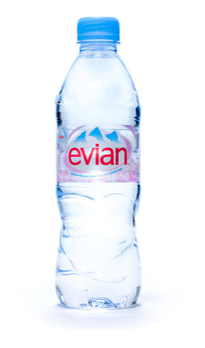
Evian water, 9 oz., $1.49 – $21.19 per gallon! $21.19 for a gallon of WATER!
And buyers don’t even know the source of Evian (Incidentally, Evian spelled backwards is Naive.).
Ever wonder why computer printers are so cheap? So they can hook you for the ink. Someone calculated the cost of the ink at – you won’t believe this – $5,200 per gallon. $5,200 PER GALLON!!!
So, the next time you’re at the pump, be glad your car doesn’t run on water, Scope, Whiteout, Pepto Bismol, Nyquil or, God forbid, printer ink!!!!!
Did You Know? (Source)
The banana cannot reproduce itself. It can be propagated only by the hand of man.
The University of Alaska spans four time zones.
The tooth is the only part of the human body that cannot heal itself.
In ancient Greece tossing an apple to a girl was a traditional proposal of marriage. Catching it meant she accepted.
Warner Communications paid 28 million for the copyright to the song Happy Birthday, which was written in 1935!
Intelligent people have more zinc and copper in their hair.
.jpg)
.jpg)
Quote of the Month:
“Whether you think you can or you think you can't, you're right.” – Henry Ford



Love Thy Neighbor
David W. Colwell, Sept. 8, 1960 – March 26, 2022
The words “Love Thy Neighbor” were taken to heart by David Colwell, director of development at Loma Linda University Health, as he changed a family’s life for generations. During decades of dedicated work on campus at LLUH, David also faithfully served the church through media ministry. As a volunteer he ensured thousands of hours were meaningfully experienced by viewers around the globe. He also served as a liaison between the BOB and various staff at Loma Linda. Through our many years working alongside David, he became a good friend.
Next month we’re planning a special memorial to David Colwell you won’t want to miss.
Low PSAs to all,
Bob Marckini and Deb Hickey
To print the BOB Tales newsletter or view the newsletter with a larger font size, click here for the PDF file.
NO MEDICAL ADVICE: Material appearing here represents opinions offered by non-medically-trained laypersons. Comments shown here should NEVER be interpreted as specific medical advice and must be used only as background information when consulting with a qualified medical professional.


